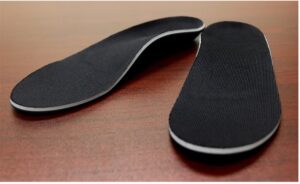Store Purchased Orthotics vs Custom
Retail vs Custom Orthotics
At their core, orthotics are devices that are placed in shoes to change how your feet meet the ground during weight-bearing. There are many different modifications that can be added and many different materials that are used to make a pair of orthotics for different purposes. As a result of this diversity and flexibility, it has become a powerful solution we as podiatrists are able to offer our patients to get them back to full activity and reduce their foot pain. But what’s the difference between a custom orthotic and a store-bought one?
Over-the-Counter Orthotics:
Affordable and Do the Job…Sometimes
It is true that most people would benefit from a supportive orthotic in their shoes.

However, it is also common for patients to come to the office with a bag of different store-bought orthotics that did nothing to aid their self-diagnosed cause of foot pain. An over-the-counter orthotic can, at times, be the perfect solution for patients that only require a little bit more arch support (e.g., plantar fasciitis). The problem is that not all brands of orthotics provide enough support, if at all. There is also the case where there is an additional deformity or other undiagnosed causes of foot pain. A retail orthotic is usually unable to offer anything but arch support unless modifications are made to it. Customizing a retail orthotic is possible, but usually, the modifications are temporary and often done with sticky felt that lasts for 1-2 weeks at most. However, they remain an attractive option because they are relatively affordable and work in a limited capacity.
| Pros | Cons |
| · Cheaper | · Limited modification ability |
| · Gives support (sometimes) and/or cushioning | · Substantial difference between brands |
| · Can’t correct underlying deformity |
Custom Orthotics:
A Lasting Device Tailored to You
Custom orthotics are just that, custom. They can be modified to fit into any type of shoe, and specific materials are chosen to meet a patient’s comfort and needs. They are molded via different techniques to your specific foot and modifications are added for a patient’s specific biomechanical needs down to the millimeter. Often, they are used to add support or decrease pressure at specific points to relieve pain. They can be used to rebalance a leg length discrepancy to prevent compensatory pain at the knee/hips/back or can be used to reduce motion at joints to prevent arthritic pain. This is all based on a comprehensive lower extremity physical exam and gait analysis allowing us to evaluate the different deformities or biomechanical tendencies of each patient to create a truly patient-tailored device.
The Cost: An Investment into a Healthy Lifestyle
 Everyone wants to be healthy given the choice. However, foot conditions can cause a significant roadblock to an active lifestyle, a necessity for overall health. It becomes a self-defeating cycle. You want to be healthy so you try to exercise, but then you develop foot/ankle pain and you can’t walk, let alone exercise. When the solution is a custom orthotic, there is a price attached. However, it must be viewed as an investment into a pain-free active lifestyle and means to living a long and healthy life. Just as you buy a gym membership or home exercise equipment (weights, stationary bikes, etc.) for hundreds to thousands of dollars, a custom orthotic is a tool to get you healthy, active, and back to the pain-free daily life you deserve.
Everyone wants to be healthy given the choice. However, foot conditions can cause a significant roadblock to an active lifestyle, a necessity for overall health. It becomes a self-defeating cycle. You want to be healthy so you try to exercise, but then you develop foot/ankle pain and you can’t walk, let alone exercise. When the solution is a custom orthotic, there is a price attached. However, it must be viewed as an investment into a pain-free active lifestyle and means to living a long and healthy life. Just as you buy a gym membership or home exercise equipment (weights, stationary bikes, etc.) for hundreds to thousands of dollars, a custom orthotic is a tool to get you healthy, active, and back to the pain-free daily life you deserve.
Written by Dr. Gavin Tsuchida
Dr. Tsuchida recently moved to San Diego from New York and is enjoying the beach and hiking when he’s not providing thoughtful, personalized care for his patients.

